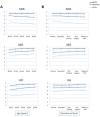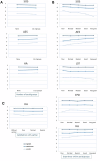Sociodemographic markers of high Sensory Processing Sensitivity: a descriptive study
- PMID: 40697741
- PMCID: PMC12280589
- DOI: 10.3389/fpsyg.2025.1617089
Sociodemographic markers of high Sensory Processing Sensitivity: a descriptive study
Abstract
Introduction: Sensory Processing Sensitivity (SPS) represents a personality trait characterised by heightened responsiveness to environmental stimuli, which can lead to both beneficial and adverse outcomes. Despite the exponential growth in knowledge about SPS in recent years, sociodemographic dimension related to this trait remains under-researched. The primary aim of this study was to analyse and provide deeper insights into the sociodemographic characteristics that may distinguish highly sensitive individuals. The present study was approached from the perspective of different sensitivity levels (low-SPS, medium-SPS and high-SPS).
Methods: To examine the sociodemographic expression of SPS, we pursued two main objectives. Firstly, by logistic regression analysis, we investigated the sociodemographic characteristics that predict high-SPS. Secondly, by analysis of variance and post hoc analysis, we investigated whether the relationship between SPS and sociodemographic variables depended on the SPS level. We conducted these analyses based on a large sample from the general population (9,447 participants were initially considered).
Results: The logistic regression analysis identified significant predictors of high sensitivity, spanning demographic, social, and wellbeing-related variables. Specifically, gender, age, civil status, number of children and type of residence as demographic variables; number of social groups and satisfaction with partner as social variables; and practise of body awareness activities as a wellbeing variable significantly predicted high-SPS. Moreover, analysis of variance and post hoc analysis, evidenced that unlike low-SPS and medium-SPS, high-SPS (SPS trait) was relatively stable with respect to sociodemographic changes.
Discussion: We discuss our findings within the context of SPS, personality traits, and their practical implications for clinical, educational, and occupational settings. We hope that this work will contribute to identifying those who may need greater support in developing their wellbeing.
Keywords: Sensory Processing Sensitivity; descriptive study; health; personality trait; sensitivity levels; sociodemographic characteristics; wellbeing.
Copyright © 2025 Morales-Botello, Betancort, Pérez-Chacón, Rodríguez-Jiménez and Chacón.
Conflict of interest statement
The authors declare that the research was conducted in the absence of any commercial or financial relationships that could be construed as a potential conflict of interest. The author(s) declared that they were an editorial board member of Frontiers, at the time of submission. This had no impact on the peer review process and the final decision.
Figures


Similar articles
-
Signs and symptoms to determine if a patient presenting in primary care or hospital outpatient settings has COVID-19.Cochrane Database Syst Rev. 2022 May 20;5(5):CD013665. doi: 10.1002/14651858.CD013665.pub3. Cochrane Database Syst Rev. 2022. PMID: 35593186 Free PMC article.
-
Gender differences in the context of interventions for improving health literacy in migrants: a qualitative evidence synthesis.Cochrane Database Syst Rev. 2024 Dec 12;12(12):CD013302. doi: 10.1002/14651858.CD013302.pub2. Cochrane Database Syst Rev. 2024. PMID: 39665382
-
Sexual Harassment and Prevention Training.2024 Mar 29. In: StatPearls [Internet]. Treasure Island (FL): StatPearls Publishing; 2025 Jan–. 2024 Mar 29. In: StatPearls [Internet]. Treasure Island (FL): StatPearls Publishing; 2025 Jan–. PMID: 36508513 Free Books & Documents.
-
Falls prevention interventions for community-dwelling older adults: systematic review and meta-analysis of benefits, harms, and patient values and preferences.Syst Rev. 2024 Nov 26;13(1):289. doi: 10.1186/s13643-024-02681-3. Syst Rev. 2024. PMID: 39593159 Free PMC article.
-
Factors that influence parents' and informal caregivers' views and practices regarding routine childhood vaccination: a qualitative evidence synthesis.Cochrane Database Syst Rev. 2021 Oct 27;10(10):CD013265. doi: 10.1002/14651858.CD013265.pub2. Cochrane Database Syst Rev. 2021. PMID: 34706066 Free PMC article.
References
-
- Ahadi B., Basharpoor S. (2010). Relationship between sensory processing sensitivity, personality dimensions and mental health. J. Appl. Sci. 10, 570574. 10.3923/jas.2010.570.574 - DOI
-
- Al-Halabí S., Herrero R., Saiz P. A., García-Portilla M. P., Corcoran P., Bascaran M. T., et al. (2010). Sociodemographic factors associated with personality traits assessed through the TCI. Pers. Individ. Dif. 48, 809–814. 10.1016/j.paid.2010.02.001 - DOI
-
- Andresen M., Goldmann P., Volodina A. (2018). Do overwhelmed expatriates intend to leave? The effects of sensory processing sensitivity, stress, and social capital on expatriates' turnover intention. Eur. Manag. Rev. 15, 315–328. 10.1111/emre.12120 - DOI
LinkOut - more resources
Full Text Sources

